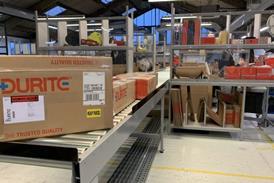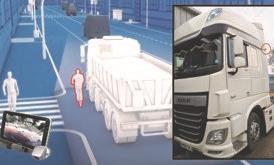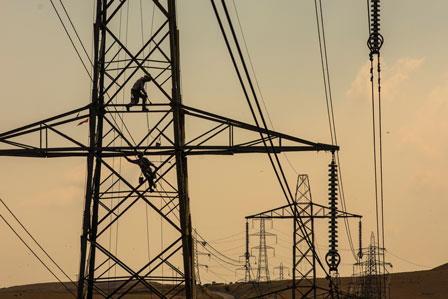
Whatever the post 2035 road transport landscape looks like it is certain to involve the use of growing amounts of electricity to power vehicles as the 120-year dominance of diesel begins to decline. Whether trucks are powered by batteries, catenaries or hydrogen - or a combination - they will need a lot of electricity, preferably from renewable sources such as wind and solar, to keep the wheels turning.
How much and where it will be needed are the $64m questions but National Grid does not have time to get the final, precise answers to these questions as building electricity infrastructure takes time – between two and four years for a large new connection - as well as lots of money. So, if grid capacity is not to become a barrier to the government’s plans for Net Zero carbon emissions it needs to get shovels in the ground very soon.

Graeme Cooper, pictured, is head of future markets at National Grid and he has been leading the charge to get the government to understand the importance of planning for the electrification of freight vehicles as well as cars and buses when it comes to building the new electric vehicle (EV) charging network. “Do it right, do it once,” has been Cooper’s consistent message.
“We started out by looking at what the transport industry needs to do, how does it need to do it and by when, so we can be ready for that change” he says. “We realised quite quickly that there was a demonstrable market failure when it came to EV charging. The government likes to give big signals and then let the market deliver but adding a grid connection to a motorway service area (MSA) can be expensive.
“Our infrastructure lasts 40 years but when it comes to car and truck charging which is in its infancy we have a business model that can only see five to 10 years out, so there is a disconnect between the business plan and the lifetime of the asset.”
Since 2019 National Grid has been working closely with government and industry on developing charging infrastructure to meet long-term demand for electric vehicles. Its proposal for a fast-charging network was supported by the Office for Zero Emission Vehicles (OZEV) in March 2020 and the government has since allocated £950m to a Rapid Charging Fund (RCF) as part of Project Rapid to deliver fast charging for cars and vans at 120 motorway and trunk road service areas (MSAs/TRSAs) in England by 2025.
A study by National Grid found that the “natural synergies” between the high voltage transmission system and the country’s strategic road network means some of these locations could be supplied by either existing National Grid infrastructure, the regional distribution network, or at low enough price that the private MSA operator would pay at least some of the cost for commercial reasons.
“At some locations the grid location is cheap enough for the market to deliver without government intervention and the one thing the government is not going to support is the chargers as that market is already super liquid and innovative,” says Cooper. “Project Rapid is intended to deliver future-proof grid capacity at MSAs and TRSAs , and that £950m should be enough for cars.
“Which is great but commercial fleets then started to say ‘what about us?’ and so National Grid reached out to the truck manufacturers to find out what is coming and when. Some said batteries, some hydrogen and others catenary. We said ‘we can provide electrons for whichever solution you choose but we can’t work it out until you tell us.”
As a result of these conversations the Grid’s study into decarbonising HGVs assumes that between 70% and 90% of electric HGVs' charging or re-fuelling will be done overnight in depots or at destinations, with only 10% to 30% needing to be delivered en route during the drivers’ 45 minute statutory break or overnight. The Grid’s analysis found that 53% to 78% of en route truck charging and hydrogen re-fuelling at MSAs and TRSAs could be provided at no extra cost to the RCF by using existing transmission connections such as substations.
“We have always advocated that the fund should be for all road users not just cars,” says Cooper. “So we looked at what the rapid charging fund would have to be to cover cars, buses, coaches and trucks all at once. We concluded that if you delivered rapid charging for cars and then came back five years later to do it all again for buses, coaches and trucks you might have to find another £650m.
“That is the size of the prize but it’s always difficult to go back to government once they have allocated a fund to say ‘can we have some more’. We calculated that delivering for buses, coaches and trucks at the same time as cars could be anywhere between 8% and 12% more expensive. The challenge for the energy sector is ‘can we deliver all that’s needed without asking for more money by driving efficiencies and programming this as a roll out’.”
Scale required
Cooper has been talking to electric truck manufacturers including Renault Trucks to understand the scale of the charging infrastructure required to handle the switch from diesel to battery or hydrogen powered electric vehicles, which has already started and will gather pace with the ban on sales of non-zero emissions trucks starting in 2035.

Renault is a leading proponent of battery electric vehicles, and its Range T E-Tech to be launched in 2023 for example will have two to six lithium-ion battery packs with a maximum installed capacity of 540kWh.
Andrew Scott, head of electric mobility at Renault Trucks, says it will be able to charge at up to 43kW on AC and 250kW with a DC rapid charger.
“Operational range on a single charge will be up to 300km, with a one-hour DC charge extending that to 500km,” he says. “A full charge from zero to maximum usable capacity would take around 2.5 hours. Developments for higher-speed charging are ongoing which will increase the speed of re-charging for longer distances, making battery electric well-suited to most UK regional and longer-haul operations.
“Renault Trucks has worked with National Grid to help determine the requirements of the national supply network for long haul freight movements, and hopes to be part of the government’s upcoming trial of vehicles and charging systems announced in May this year.”
In a worst case example, if say 50 trucks want to rapid charge simultaneously at an MSA at 250kW each that will require a 12.5MW connection just for the trucks, on top of the load for charging cars and all the other electrical services on site. If an MSA has truck parks on both sides of the carriageway of a motorway that would require a 25MW connection just for the trucks – more than a typical small town uses today – and most MSAs currently have only a 1MW connection.
“We know broadly for cars the connection range will be between 5MW and 8MW. If you then future-proof for buses, trucks and coaches we could need anything between 15MW and 20MW,” says Cooper. “It isn’t an exact science and we engineer for best endeavours. A proportion of trucks will want to fast charge in the driver’s 45 minute break and that will be a MW scale charger. Then there will be a proportion who want to plug in and charge at maybe 150kW for six or seven hours overnight. So it will a mixture of the two and that might be different depending on where you are in the country.
“We don’t know how many of those trucks will be hydrogen or battery electric or hybrids, but that doesn’t matter because you are likely to make hydrogen through electrolysis where you refuel and that needs a grid connection. We don’t need the industry to tell us if the truck will be battery or hydrogen – the grid connection stays about the same size.”
Least regrets
National Grid has suggested to ministers that if they wait to see which way long distance transport goes in terms of motive power it will be too late for the infrastructure to keep up - decisions need to be taken now “on a least regrets basis”.
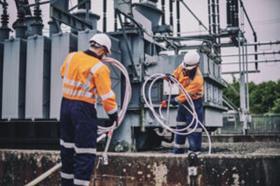
No one knows now how far and fast battery technology will progress however – if it becomes possible for more than 90% of battery or hydrogen trucks to run depot to depot without the need for en route recharging, that expensive 20MW MSA connection could become redundant – a stranded asset. It could also be possible to downsize the connection by making hydrogen or putting a buffer battery in between the electric trucks and the grid to store energy overnight when demand is low.
“No one has a crystal ball,” admits Cooper. “Will 10% of charging be en route, or will it be 30%? From a diesel perspective we know what percentage of fuelling is done en route versus what is done at a depot. But you are not replacing liquid fuel with an electron on a like for like basis. Truck operators may have a different operating model if they have a different fuel. But under most scenarios you will need evenly spaced electrical capacity along the strategic road network.
“The risk of stranded assets is very small.”
The en route charging plan is based on up to 90% of battery or hydrogen trucks refuelling at a depot or their destination. This percentage will probably be even higher for 18 tonne or 26 tonne distribution vehicles which rarely see a motorway – and have to go zero emissions by 2035, five years before heavier vehicles. This will also require extra grid capacity away from the road network as few DCs currently have anything like a 20MW connection.
“What is apparent is that depot charging will be the core of that business model,” says Cooper. “That leads to another challenge as a lot of depots are a piece of land with a shed that was a good deal at the time. One thing we have started to see in the logistics industry is people asking ‘should I be thinking about moving my depot to where the grid is?’
“We are getting a lot of enquiries from bus and truck operators asking ‘how far is my depot from the grid?’ and a lot are realising this is not a grid problem but a property opportunity. In their medium to long term property strategy should they relocate their DC next to a substation under a powerline?
“That land is generally low value because people don’t want to live next to a transformer – but buses and truck don’t care. This will require the logistics industry to think about its business model, the location of depots and how they run their trucks. It is complex but at least people are now asking the questions. Often when there is a challenge people raise their game to look for other business opportunities.”
If the grid can’t come to you…
Driving up the M1 or M40 and seeing the number of large sheds still being built near motorway junctions would indicate that few developers are thinking about grid connections yet – but that isn’t the case, says Cooper.
“One or two of the more progressive developers have already asked ‘where can I see a map of the substations?’,” he says. “There is a 61% synergy between the grid network and the strategic road network and if you look at the sheds going up now I would be surprised if you didn’t see grid infrastructure nearby.”

When it comes to major cities like London, Cooper points to the electric depot model being adopted by DPD. He argues that urban distribution will see depots located on the edges of towns and cities where trucks will drop parcels and other goods for last mile delivery on electric vans. “Instead of having charging in the cities for those bigger vehicles it is likely to be on the periphery so they can drop and get out, he says. “But we are a business that provides wires in the places people want them and we don’t profess to know all the answers which is why we spend so much time talking to the logistics industry and the vehicle OEMs.
“We started asking those questions four years ago and the view then was that trucks were going to be more hydrogen than battery. What’s interesting now is that those discussions are weighted much more towards battery. We are not saying it is either/or - what you will probably need is both.”
What is National Grid and how is it paid for?
National Grid is a listed PLC that owns 4,500 miles of high voltage (275kV and 400kV) overhead and 900 miles of underground transmission wires and over 300 substations in England and Wales. As a private monopoly it is regulated by Ofgem which controls the prices it charges users for access to the grid and approves its capital expenditure.
Ofgem’s regulatory framework is called Revenue = Incentives + Innovation + Outputs (RIIO) which is meant to incentivise innovation and develop sustainable energy networks at the lowest cost for current and future customers.
The intermediate medium to low voltage (240V and 440V) networks that connect most users to the grid are owned by 14 distribution network operators (DNOs) – but sometimes for large loads close to the transmission system the grid can offer a direct connection.
“People in the transport sector don’t care who owns the wires,” says Cooper. “National Grid is like the motorway of the energy system and the DNOs are the local roads. We couldn’t run the country just with motorways as they don’t get you everywhere and we couldn’t do it just with local roads as they would get very congested. They are however inter-related - the cheapest for delivering the capacity wins.
“There are a couple of locations on the motorway network where a number of sites are physically not that far apart so one transmission location could serve four or five MSAs. As a connection it is expensive but if it’s shared across four of five MSAs, the cost per connection is quite cheap.
“There is no rule of thumb. If there is DNO capacity already or they can deliver it cheaply they will deliver. But in adding new demand at distribution level we still see that at transmission level, so whether National Grid is delivering last mile capacity to an MSA or not we have to be involved in the conversation.”
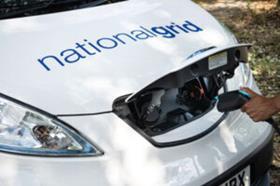
The £950m RCF has been allocated by the Treasury to the Department for Transport (DfT) rather than the energy department despite the fact that the money will be spent upgrading energy infrastructure.
“We are regulated by Ofgem to deliver infrastructure in an economic and efficient way,” says Cooper. “Normally the people paying for that are bill payers and nothing has changed. The RCF will cover the connection costs and Ofgem will still have oversight. The difference is that the funding will come from the DfT to whoever the delivery body is. We suspect it might be National Highways so they would be the customer to National Grid or the DNOs. It will still have to be economic and efficient.”
The “great unknown” as Cooper puts it remains how users will pay for access to the public recharging network.
“We know the government has put a business plan together and we believe that in the autumn there will be a consultation on how they are going to do this,” he says. “From a grid perspective the business model doesn’t impact on us as we are bringing future-proofed, scalable grid capacity.
“We do know the DfT is strong on the principle that there is no free riding, so no one should get an additional benefit just because they are at an MSA. Whoever the charge point company is, they will ultimately have to pay for that infrastructure.”
The risk of getting the business model wrong however is that another technology – for argument’s sake, small scale nuclear reactors that serve a regional electricity network – could come along and mean a lot of money spent on future-proofing a national grid would be for demand that never comes.
What about putting hydrogen in the gas network?
National Grid also owns the high pressure gas transmission system National Grid Gas but is selling a 60% stake to Australian investment group Macquarie and Canadian firm British Columbia Investment with an option to purchase the remaining 40% stake next year.
National Grid Gas is testing a hydrogen gas network in the North of England called the FutureGrid project. If this works it could lead to a full-scale conversion of the existing national gas transmission system to transport hydrogen which, if made with renewable electricity, could be a zero emissions fuel for both buildings and road vehicles.
“There is work going on within the gas transmission business to inject hydrogen into the gas network,” says Cooper. “You can blend it up to about 20% hydrogen with little or no modifications to appliances.
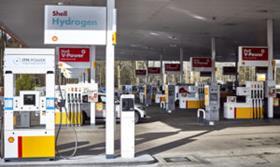
“That makes the emissions from boilers a little cleaner and it is a good step in the right direction. Home heating is likely to be a mixture of electric and hydrogen and it is likely that geography will be an important factor.”
This is because parts of the UK like Teesside, Humberside, Aberdeen and South Wales which have traditionally been home to heavy energy intensive industries like steel and chemicals will probably need to make the switch to green hydrogen to decarbonise.
“If you have a strong demand and therefore a strong supply of hydrogen you are more likely to see hydrogen trucks and heating systems,” explains Cooper. “I am in the Thames Valley which is all data centres and computer businesses so this is the least likely area to see any kind of hydrogen generation.
“That is why we have regional strategies – you cannot say that because something works in London it has to work in Glasgow. You can have big high levels plans but they need to be interpreted locally.”

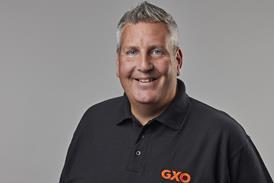

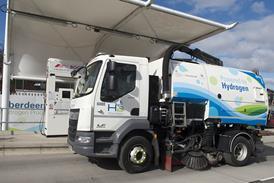


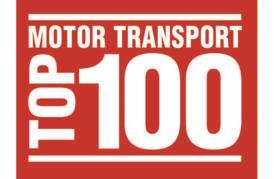
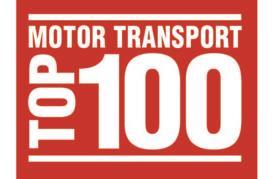
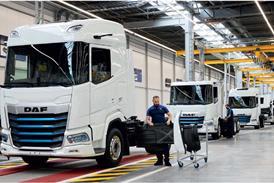
![Mercedes-Benz_eActros_600_(1)[1]](jpg/17820_mercedesbenz_eactros_600_11_978080.jpg)

